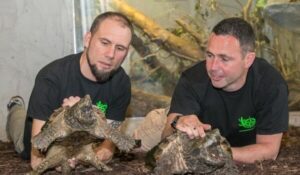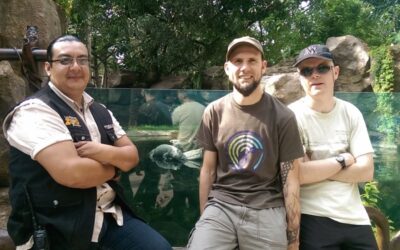Citizen science contributes to conservation of Alta Verapaz spikethumb frog, Guatemala.
The mountainous regions of the tropics are famous for their high levels of biodiversity, with many species only being found in a highly restricted geographical region. These narrow ranges of endemic species can lead to big problems for populations from habitat loss. In some cases only a few hectares of forest clearance might be enough to cause dramatic declines or even extinctions of an entire species.
Endemic Amphibians
The Central Highlands of Guatemala are a hotspot for endemic amphibians, many of which are only found in a handful of mountain ranges. Of the 13 or so species endemic to the region, the Alta Verapaz spikethumb frog (Plectrohyla teuchestes) is one of the rarest in Guatemala.
The Alta Verapaz spikethumb frog is a very large tree frog that reaches over 70mm in length and can weigh around 45g. That may not sound like much, but for a tree frog that is massive! The name spikethumb frog comes from bony spikes that protrude from the thumb that is especially enlarged in males, and is thought to be used during combat with other males for the right to mate with females.
The Alta Verapaz spikethumb frog
Until recently the Alta Verapaz spikethumb frog was only known from one locality, Finca Los Alpes – the location where it was first discovered in 1960. At that time it was considered to be another closely related species, the Guatemalan spikethumb frog (P. guatemalensis). It was not until 1992 when studies confirmed that the population of the Guatemalan spikethumb frog found at Finca Los Alpes was in fact a new species, and it was named the Alta Verapaz spikethumb frog.
Despite extensive surveys, the Alta Verapaz spikethumb frog had not been found since 2004 at Finca Los Alpes. The site has suffered from dramatic deforestation, and it seems unlikely that the species is still present there.
Is the spikethumb frog extinct?
So does that mean the Alta Verapaz spikethumb frog is extinct? Thankfully not. In 2015, Indigo Expeditions led a group of volunteers on an amphibian and reptile survey of a location on the same mountain range 40km away from Finca Los Alpes.
That team was responsible for finding two large treefrogs that have been identified as Alta Verapaz spikethumb frogs, and we have since found five more individuals all of which have been in the same canyon.
Citizen Science
The mountains of Alta Verapaz are remote and difficult to access and so there is great hope that other populations of the Alta Verapaz spikethumb frog may exist in yet undiscovered corners.
This story is testament to the power of citizen science, and that anyone who goes exploring in remote corners of the world can contribute to wildlife conservation.

















0 Comments